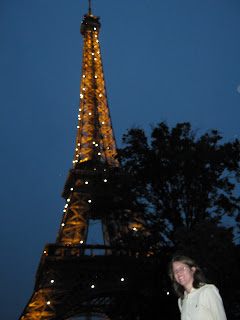This weekend was an introduction to the City of Light - now I'm learning about the City of Lasers. During the past two days, I've been getting to know the lab setup, gaining a bit of background knowledge, and generally figuring out how the lab group works. Things are going well; the other members of the lab group generally speak enough English that we can communicate, although this may mean that I don't get to practice my French very much. Clèment and Iryna, whom I think are both doctoral candidates, work in the same little partition of the optics lab as I will be, so we'll have to take turns in the lab.
Although it's not a surprise to me, I was pleased by how happy I am to be doing experimental work in a lab. I'd been feeling a bit nervous at the beginning of the week, between all the new names and faces, the unfamiliar setting, and my new responsibilities, but life is good when I'm fiddling with lasers and writing in a lab notebook. Time passes quickly.
Yesterday and today I've been doing little baby experiments to get used to the setup. It's a pretty straightforward optical system, though it's very delicately aligned and I certainly don't want to be the one who bumps it out of place. I don't see why I wouldn't be allowed to describe the system, but maybe I'll wait and ask Mélanie if she minds.
At any rate, I've been checking the dependence of the organic laser's spectral line width on the aperture of the grating spectrometer used to measure it. The active modes of the microcavity laser are uniformly spaced in wavelength and are approximately all the same spectral width, with their amplitudes contained in an envelope that looks sort of Gaussian, though I'm not sure that it necessarily is. As the spectrometer aperture increases, the observed peaks for each mode broaden, eventually overlapping each other and making quite a strange spectrum. The hope was that for apertures under some particular width, the spectral line width would remain constant, so we would know that the aperture wasn't affecting the line width.
Over the course of a few hours (I am still becoming accustomed to the setup and made many stupid mistakes, though fortunately nothing that was difficult to reverse), I took spectra at aperture widths ranging from 0.7 to 0.1 microns. One set of spectra had an exposure time of 3 seconds, meaning that each spectrum I observed was averaged over 30 pulses of the pumping laser (and thus over 30 pulses of the organic laser as well), while the other set of spectra recorded just the response to a single pulse.
When I began the analysis, I was surprised and pleased to discover that this lab group uses Igor Pro, software with which I've gained a good deal of experience over the past two years at school. So I happily fit peaks to Gaussians and averaged spectral widths and calculated standard errors, and the net result...doesn't exactly show a threshold. There's clearly a point after which decreasing the aperture has a smaller effect on line width than at wider apertures, but it's not a flat cutoff. We can probably use that semi-threshold aperture width for the remainder of the experiments, but it's strange that the data don't do what we expected. I hope it's not another stupid mistake on my part.
The next step is to investigate the relationship between line width and lasing portion of the Fabry-Perot cavities. The cavities are long strips of material, and rays bouncing around in the middle portion won't care about the corners of the cavity, but rays towards the edges will, presumably. At the very end of the day, I took some spectra of both the middle and edges of a sample, so I'll go through that data tomorrow morning and see what I find!
I really enjoy physics research.
Last night, several of the REU students visited the Eiffel Tower. The weather was not very good at all, but it was fun to see such a famous site. I'm planning on going back at least once more, though visiting the top is out of the question. Here are a few pictures of the Eiffel Tower at dusk in the rain (they light it up nicely at night).





No comments:
Post a Comment